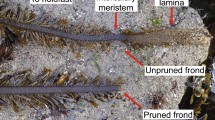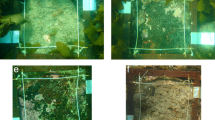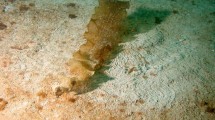Abstract
Low recruitment due to limitations of propagule supply or post-settlement survival reinforces dominance of turf algal assemblages that replace canopy algae following large-scale losses. However, post-recruitment processes that hinder juvenile growth and survival (epiphytic overgrowth, grazing, physical stress) also could impede recovery. To evaluate the contribution of recruitment, growth, and survival of young sporophytes to recovery of degraded kelp populations and key factors driving post-recruitment tissue loss and mortality, we followed cohorts of juvenile kelp Saccharina latissima at two defoliated sites in Nova Scotia. We also monitored kelp recruitment, abundance, size structure, and macroalgal composition for 5.5 years. Recruit densities were an order of magnitude lower compared to previous studies in the region. Large decreases in blade area of juveniles were related to cover by the invasive bryozoan Membranipora membranacea, grazing by small snails Lacuna vincta, and warm seawater temperatures. Cohort survival was low (time to 50% mortality 2.5–5.5 months) and increased risk of death was directly related to bryozoan encrustation. Modest seasonal or interannual gains in kelp abundance were lost during periods of peak temperature, which showed a warming trend during the study, favouring persistence of widespread turf-forming, opportunistic and invasive algae. We conclude that low recruitment success, high rate of tissue loss relative to growth, and high mortality, inhibited kelp recovery. Impacts of epiphytic overgrowth, grazing, and warm temperatures on these processes highlight the need to protect intact kelp populations, growing in favourable conditions, to maintain positive interactions that increase resilience to undesirable regime shifts.

Photo credits: R. E. Scheibling







Similar content being viewed by others
References
Andersen GS, Steen H, Christie H, Fredriksen S, Moy FE (2011) Seasonal patterns of sporophyte growth, fertility, fouling, and mortality of Saccharina latissima in Skagerrak, Norway: implications for forest recovery. J Mar Biol. https://doi.org/10.1155/2011/690375
Andersen GS, Pedersen MF, Nielsen SL (2013) Temperature acclimation and heat tolerance of photosynthesis in Norwegian Saccharina latissima (Laminariales, Phaeophyceae). J Phycol 49:689–700
Anderson LM, Martone PT (2014) Biomechanical consequences of epiphytism in intertidal macroalgae. J Exp Biol 217:1167–1174
Benedetti-Cecchi L, Pannacciulli F, Bulleri F, Moschella PS, Airoldi L, Relini G, Cinelli F (2001) Predicting the consequences of anthropogenic disturbance: large-scale effects of loss of canopy algae on rocky shores. Mar Ecol Prog Ser 214:137–150
Bennett S, Wernberg T (2014) Canopy facilitates seaweed recruitment on subtidal temperate reefs. J Ecol 102:1462–1470
Bennett S, Wernberg T, de Bettignies T, Kendrick GA, Anderson RJ (2015a) Canopy interactions and physical stress gradients in subtidal communities. Ecol Lett 18:677–686
Bennett S, Wernberg T, Harvey ES, Santana-Garcon J, Saunders BJ (2015b) Tropical herbivores provide resilience to a climate-mediated phase shift on temperate reefs. Ecol Lett 18:714–723
Black R (1976) The effects of grazing by the limpet, Acmaea insessa, on the kelp, Egregia laevigata, in the intertidal zone. Ecology 57:265–277
Blain C, Gagnon P (2013) Interactions between thermal and wave environments mediate intracellular acidity (H2SO4), growth, and mortality in the annual brown seaweed Desmarestia viridis. J Exp Mar Biol Ecol 440:176–184
Burek KE, O’Brien JM, Scheibling RE (2018) Wasted effort: recruitment and persistence of kelp on algal turf. Mar Ecol Prog Ser 600:3–19
Cancino JM, Munoz J, Orellana MC (1987) Effects of the bryozoan Membranipora tuberculata (Bosc.) on the photosynthesis and growth of Gelidium rex Santelices and Abbot. J Exp Mar Biol Ecol 113:105–112
Chapman ARO (1984) Reproduction, recruitment, and mortality in two species of Laminaria in Southwest Nova Scotia. J Exp Mar Biol Ecol 78:99–109
Chapman ARO (1986) Age versus stage: an analysis of age- and size-specific mortality and reproduction in a population of Laminaria longicruris Pyl. J Exp Mar Biol Ecol 97:113–122
Chapman ARO, Craigie JS (1977) Seasonal growth in Laminaria longicruris: relations with dissolved inorganic nutrients and internal reserves of nitrogen. Mar Biol 40:197–205
Chenelot H, Konar B (2007) Lacuna vincta (Mollusca, Neotaenioglossa) herbivory on juvenile and adult Nereocystis luetkeana (Heterokontophyta, Laminariales). Hydrobiologia 583:107–118
Coyer JA, Zaugg-Haglund AC (1982) A demographic study of the elk kelp, Pelagophycusporra (Laminariales, Lessoniaceae), with notes on Pelagophycus × Macrocystis hybrids. Phycologia 21:399–407
Davison IR, Greene RM, Podolak EJ (1991) Temperature acclimation of respiration and photosynthesis in the brown alga Laminaria saccharina. Mar Biol 110:449–454
Dayton PK, Currie V, Gerrodette T, Keller BD, Rosenthal R, Ven Tresca D (1984) Dynamics and stability of some California kelp communities. Ecol Monogr 54:253–289
de Bettignies T, Thomsen MS, Wernberg T (2012) Wounded kelps: patterns and susceptibility to breakage. Aquat Biol 17:223–233
Dean TA, Schroeter SC, Dixon JD (1984) Effects of grazing by two species of sea urchins (Strongylocentrotus franciscanus and Lytechinus anamesus) on recruitment and survival of two species of kelp (Macrocystis pyrifera and Pterygophora californica). Mar Biol 78:301–313
Deiman M, Iken K, Konar B (2012) Susceptibility of Nereocystis luetkeana (Laminariales, Ochrophyta) and Eualaria fistulosa (Laminariales, Ochrophyta) spores to sedimentation. Algae 27:115–123
Dixon J, Schroeter SC, Kastendiek J (1981) Effects of the encrusting bryozoan, Membranipora membranacea, on the loss of blades and fronds by the giant kelp, Macrocystis pyrifera (Laminariales). J Phycol 17:341–345
Dobkowski K (2017) The role of kelp crabs as consumers in bull kelp forests—evidence from laboratory feeding trials and field enclosures. PeerJ. https://doi.org/10.7717/peerj.3372
Duggins D, Eckman JE, Siddon CE, Klinger T (2001) Interactive roles of mesograzers and current flow in survival of kelps. Mar Ecol Prog Ser 223:143–155
Fernández C (2011) The retreat of large brown seaweeds on the north coast of Spain: the case of Saccorhiza polyschides. Eur J Phycol 46:352–360
Filbee-Dexter K, Wernberg T (2018) The rise of turfs: a new battlefront for globally declining kelp forests. Bioscience 68:64–76
Filbee-Dexter K, Feehan CJ, Scheibling RE (2016) Large-scale degradation of a kelp ecosystem in an ocean warming hotspot. Mar Ecol Prog Ser 543:141–152
Fralick RA, Turgeon KW, Mathieson AC (1974) Destruction of kelp populations by Lacuna vincta (Montagu). Nautilus 88:112–114
Franco JN, Wernberg T, Bertocci I, Jacinto D, Maranhão P, Pereira T, Martinez B, Arenas F, Sousa-Pinto I, Tuya F (2017) Modulation of different kelp life stages by herbivory compensatory growth versus population decimation. Mar Biol 164:164. https://doi.org/10.1007/s00227-017-3196-8
Gagnon P, Himmelman JH, Johnson LE (2003) Algal colonization in urchin barrens: defense by association during recruitment of the brown alga Agarum cribrosum. J Exp Mar Biol Ecol 290:179–196
Gaylord B, Reed DC, Raimondi PT, Washburn L, McLean SR (2002) A physically based model of macroalgal spore dispersal in the wave and current-dominated nearshore. Ecology 83:1239–1251
Gaylord B, Reed DC, Raimondi PT, Washburn L (2006) Macroalgal spore dispersal in coastal environments: mechanistic insights revealed by theory and experiment. Ecol Monogr 76:481–502
Gorman D, Connell SD (2009) Recovering subtidal forests in human-dominated landscapes. J Appl Ecol 46:1258–1265
Graham MH (2003) Coupling propagule output to supply at the edge and interior of a giant kelp forest. Ecology 84:1250–1264
Harley CDG, Anderson KM, Demes KW, Jorve JP, Kordas RL, Coyle TA, Graham MH (2012) Effects of climate change on global seaweed communities. J Phycol 48:1064–1078
Hertz-Picciotto I, Rockhill B (1997) Validity and efficiency of approximation methods for tied survival times in Cox regression. Biometrics 53:1151–1156
Hurd CL, Durante KM, Chia F-S, Harrison PJ (1994) Effect of bryozoan colonization on inorganic nitrogen acquisition by the kelps Agarum fimbriatum and Macrocystis integrifolia. Mar Biol 121:167–173
Irving AD, Connell SD (2006) Predicting understorey structure from the presence and composition of canopies: an assembly rule for marine algae. Oecologia 148:491–502
Isæus M, Malm T, Persson S, Svensson A (2004) Effects of filamentous algae and sediment on recruitment and survival of Fucus serratus (Phaeophyceae) juveniles in the eutrophic Baltic Sea. Eur J Phycol 39:301–307
Johnson LE, Brawley SH (1998) Dispersal and recruitment of a canopy-forming intertidal alga: the relative roles of propagule availability and post-settlement processes. Oecologia 117:517–526
Johnson CR, Mann KH (1986) The importance of plant defense abilities to the structure of subtidal seaweed communities: the kelp Laminaria longicruris de la Pylaie survives grazing by the snail Lacuna vincta (Montagu) at high population densities. J Exp Mar Biol Ecol 97:231–267
Johnson CR, Mann KH (1988) Diversity, patterns of adaptation, and stability of Nova Scotian kelp beds. Ecol Monogr 58:129–154
Kennelly SJ (1987) Physical disturbances in an Australian kelp community. I. Temporal effects. Mar Ecol Prog Ser 40:145–153
Kinlan BP, Graham MH, Sala E, Dayton PK (2003) Arrested development of giant kelp (Macrocystis pyrifera, Phaeophyceae) embryonic sporophytes: a mechanism for delayed recruitment in perennial kelps? J Phycol 39:47–57
Krumhansl KA, Scheibling RE (2011a) Detrital production in Nova Scotian kelp beds: patterns and processes. Mar Ecol Prog Ser 421:67–82
Krumhansl KA, Scheibling RE (2011b) Spatial and temporal variation in grazing damage by the gastropod Lacuna vincta in Nova Scotian kelp beds. Aquat Biol 13:163–173
Krumhansl KA, Lee JM, Scheibling RE (2011) Grazing damage and encrustation by an invasive bryozoan reduce the ability of kelps to withstand breakage by waves. J Exp Mar Biol Ecol 407:12–18
Krumhansl KA, Okamoto DK, Rassweiler A, Novak M, Bolton JJ, Cavanaugh KC, Connell SD, Johnson CR, Konar B, Ling SD et al (2016) Global patterns of kelp forest change over the past half-century. Proc Natl Acad Sci USA 113:13785–13790
Krumhansl KA, Bergman JN, Salomon AK (2017) Assessing the ecosystem-level consequences of a small-scale artisanal kelp fishery within the context of climate-change. Ecol Appl 27:799–813
Levin PS, Coyer JA, Petrik R, Good TP (2002) Community-wide effects of nonindigenous species on temperate rocky reefs. Ecology 83:3182–3193
Lubchenco J (1983) Littornia and Fucus: effects of herbivores, substratum heterogeneity, and plant escapes during succession. Ecology 64:1116–1123
Mann KH (1972) Ecological energetics of the seaweed zone in a marine bay on the Atlantic coast of Canada. II. Productivity of the seaweeds. Mar Biol 14:199–209
McConnico LA, Foster MS (2005) Population biology of the intertidal kelp, Alaria marginata Postels and Ruprecht: a non-fugitive annual. J Exp Mar Biol Ecol 324:61–75
Moy FE, Christie H (2012) Large-scale shift from sugar kelp (Saccharina latissima) to ephemeral algae along the south and west coast of Norway. Mar Biol Res 8:309–321
O’Brien JM, Scheibling RE (2016) Nipped in the bud: mesograzer feeding preference contributes to kelp decline. Ecology 97:1873–1886
O’Brien JM, Scheibling RE (2018) Turf wars: competition between foundation and turf-forming species on temperate and tropical reefs and its role in regime shifts. Mar Ecol Prog Ser 590:1–17
O’Brien JM, Scheibling RE, Krumhansl KA (2015) Positive feedback between large-scale disturbance and density-dependent grazing decreases resilience of a kelp bed ecosystem. Mar Ecol Prog Ser 522:1–13
Peduzzi P, Concato J, Feinstein AR, Holford TR (1995) Importance of events per independent variable in proportional hazards regression analysis II. Accuracy and precision of regression estimates. J Clin Epidemiol 48:1503–1510
Perkol-Finkel S, Airoldi L (2010) Loss and recovery potential of marine habitats: an experimental study of factors maintaining resilience in subtidal algal forests at the Adriatic Sea. PLoS ONE 5:e10791. https://doi.org/10.1371/journal.pone.0010791
R Core Team (2015) R: a language and environment for statistical computing. R Foundation for Statistical Computing, Vienna. http://www.R-project.org. Accessed 10 Oct 2017
Reed DC (1990) The effects of variable settlement and early competition on patterns of kelp recruitment. Ecology 71:776–787
Reed DC, Foster MS (1984) The effects of canopy shadings on algal recruitment and growth in a giant kelp forest. Ecology 65:937–948
Reed DC, Laur DR, Ebeling AW (1988) Variation in algal dispersal and recruitment: the importance of episodic events. Ecol Monogr 58:321–335
Sales M, Ballesteros E (2012) Seasonal dynamics and annual production of Cystoseira crinita (Fucales: Ochrophyta)-dominated assemblages from the northwestern Mediterranean. Sci Mar. https://doi.org/10.3989/scimar.03465.16d
Saunders M, Metaxas A (2008) High recruitment of the introduced bryozoan Membranipora membranacea is associated with kelp bed defoliation in Nova Scotia, Canada. Mar Ecol Prog Ser 369:139–151
Saunders M, Metaxas A (2009) Effects of temperature, size, and food on the growth of Membranipora membranacea in laboratory and field studies. Mar Biol 156:2267–2276
Scheibling RE (1986) Increased macroalgal abundance following mass mortalities of sea urchins (Strongylocentrotus droebachiensis) along the Atlantic coast of Nova Scotia. Oecologia 68:186–198
Scheibling RE, Gagnon P (2006) Competitive interactions between the invasive green alga Codium fragile ssp. tomentosoides and native canopy-forming seaweeds in Nova Scotia (Canada). Mar Ecol Prog Ser 325:1–14
Scheibling RE, Gagnon P (2009) Temperature-mediated outbreak dynamics of the invasive bryozoan Membranipora membranacea in Nova Scotian kelp beds. Mar Ecol Prog Ser 390:1–13
Scheibling RE, Lauzon-Guay J-S (2010) Killer storms: North Atlantic hurricanes and disease outbreaks in sea urchins. Limnol Oceanogr 55:2331–2338
Scheibling RE, Hennigar AW, Balch T (1999) Destructive grazing, epiphytism, and disease: the dynamics of sea urchin-kelp interactions in Nova Scotia. Can J Fish Aquat Sci 56:2300–2314
Scheibling RE, Feehan CJ, Lauzon-Guay JS (2013) Climate change, disease and the dynamics of a kelp-bed ecosystem in Nova Scotia. In: Fernández-Palocios JM, Nascimiento LD, Hernández JC, Clement S, González A, Diaz-González JP (eds) Climate change: perspectives from the Atlantic: past, present and future. Servicio de Publicaciones de la Universidad de La Laguna, Tenerife, pp 41–81
Schiel DR, Foster MS (2006) The population biology of large brown seaweeds: ecological consequences of multiphase life histories in dynamic coastal environments. Annu Rev Ecol Evol Syst 37:343–372
Schiel DR, Lilley SA (2011) Impacts and negative feedbacks in community recovery over eight years following removal of habitat-forming macroalgae. J Exp Mar Biol Ecol 407:108–115
Simonson EJ, Scheibling RE, Metaxas A (2015) Kelp in hot water: I. Warming seawater temperature induces weakening and loss of kelp tissue. Mar Ecol Prog Ser 537:89–104
Staehr PA, Wernberg T (2009) Physiological responses of Ecklonia radiata (Laminariales) to a latitudinal gradient in ocean temperature. J Phycol 45:91–99
Tamburello L, Bulleri F, Bertocci I, Maggi E, Benedetti-Cecchi L (2013) Reddened seascapes: experimentally induced shifts in 1/f spectra of spatial variability in rocky intertidal assemblages. Ecology 94:1102–1111
Therneau T (2015) A package for survival analysis in S. version 2.38. https://CRAN.R-project.org/package=survival. Accessed 10 Oct 2017
Toohey BD, Kendrick GA (2007) Survival of juvenile Ecklonia radiata sporophytes after canopy loss. J Exp Mar Biol Ecol 349:170–182
Wei LJ, Lin DY, Weissfeld L (1989) Regression analysis of multivariate incomplete failure time data by modeling marginal distribution. J Am Stat Assoc 84:1065–1073
Wernberg T, Thomsen M, Tuya F, Kendrick GA, Staehr PA, Toohey BD (2010) Decreasing resilience of kelp beds along a latitudinal temperature gradient: potential implications for a warmer future. Ecol Lett 13:685–694
Wernberg T, Smale DA, Tuya F, Thomsen MS, Langlois TJ (2013) An extreme climatic event alters marine ecosystem structure in a global biodiversity hotspot. Nat Clim Change 3:78–82
Wernberg T, Bennett S, Babcock RC, de Bettignies T, Cure K, Depczynski M, Dufois F, Fromont J, Fulton CJ, Hovey RK et al (2016) Climate-driven regime shift of a temperate marine ecosystem. Science 353:169–172
Wilson KL, Kay LM, Schmidt AL, Lotze HK (2015) Effects of increasing water temperatures on survival and growth of ecologically and economically important seaweeds in Atlantic Canada: implications for climate change. Mar Biol 162:2431–2444
Witman JD (1987) Subtidal coexistence: storms, grazing, mutualism, and the zonation of kelps and mussels. Ecol Monogr 57:167–187
Witman JD, Lamb RW (2018) Persistent differences between coastal and offshore kelp forest communities in a warming Gulf of Maine. PLoS ONE 13:e0189388. https://doi.org/10.1371/journal.pone.0189388
Worm B, Lotze HK (2006) Effects of eutrophication, grazing, and algal blooms on rocky shores. Limnol Oceanogr 51:569–579
Worm B, Sommer U (2000) Rapid direct and indirect effects of a single nutrient pulse in a seaweed-epiphyte-grazer system. Mar Ecol Prog Ser 202:283–288
Acknowledgements
We are indebted to a long list of assistants without whom the extensive fieldwork and image analysis required for this project could not have been completed. J. Lindley oversaw safety of boat and diving operations and provided technical assistance in the field. K. Filbee-Dexter, D. Denley, C. Feehan, E. Simonson, K. Krumhansl, A. Harding, K. Sorochan, A. Metaxas, R. Buchwald, K. Burek, A. McCurdy, V. Burdett-Coutts, F. Francis, C. Civelek, J. Corbin, T. Grant, M. Harris, L. Nagel, O. Pisano, J. McLellan, and A. Balbar assisted with field work. K. Burek, K. Sorochan, E. Higgins, E. Bonang, and G. Wagner contributed to image analysis. K. Filbee-Dexter, K. Krumhansl, M. Wong, H. Lotze, S. Walde, I. Côté, John Witman and another anonymous reviewer provided helpful comments on earlier drafts. This research was funded by a Discovery Grant to R.E.S. from the Natural Sciences and Engineering Research Council (NSERC) of Canada. J.M.O. was supported by a Dalhousie Killam Scholarship, an NSERC Canada Graduate Scholarship, a Nova Scotia Graduate Scholarship, and a Dalhousie President’s Award.
Funding
The study was funded by a Natural Sciences and Engineering Research Council of Canada Discovery Grant (NSERC, Grant number 44211) to RES.
Author information
Authors and Affiliations
Corresponding author
Ethics declarations
Conflict of interest
The authors declare that they have no conflict of interest.
Ethical approval
This article does not contain any studies with animals performed by any of the authors.
Additional information
Responsible Editor: K. Bischof.
Reviewed by J. D. Witman and an undisclosed expert.
Electronic supplementary material
Below is the link to the electronic supplementary material.
Rights and permissions
About this article
Cite this article
O’Brien, J.M., Scheibling, R.E. Low recruitment, high tissue loss, and juvenile mortality limit recovery of kelp following large-scale defoliation. Mar Biol 165, 171 (2018). https://doi.org/10.1007/s00227-018-3423-y
Received:
Accepted:
Published:
DOI: https://doi.org/10.1007/s00227-018-3423-y




